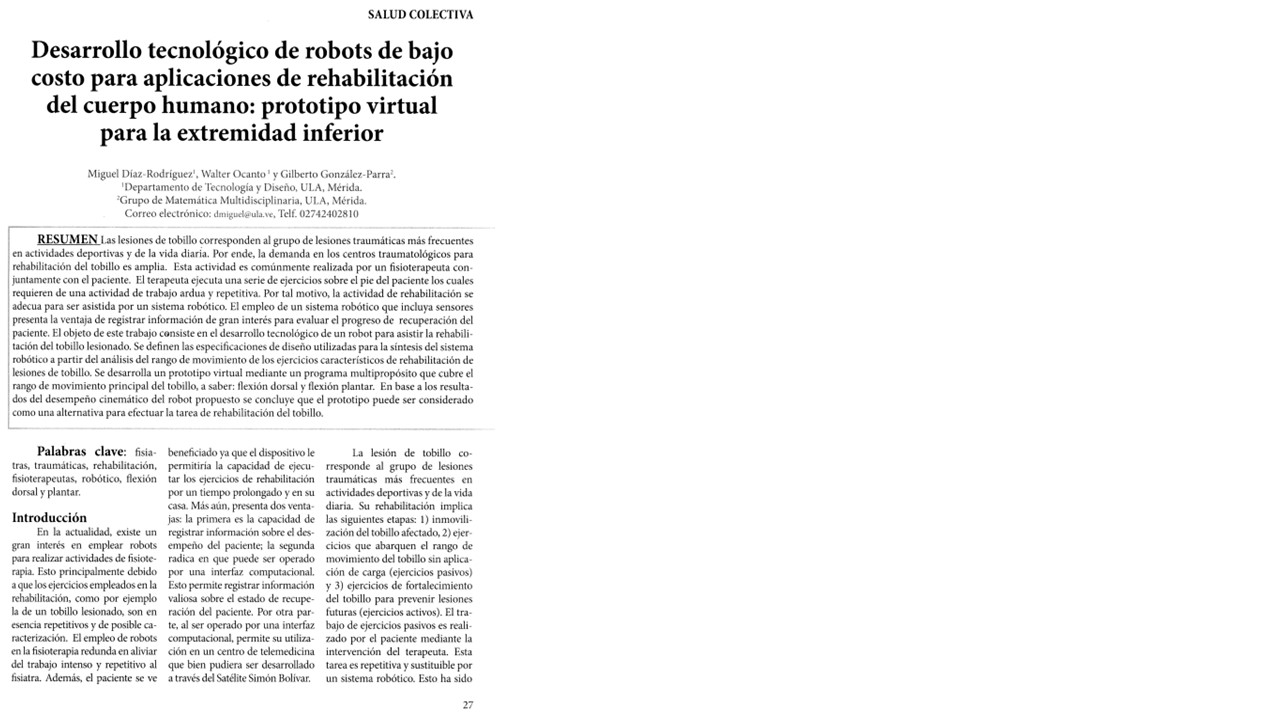Technological development of low-cost robots for human body rehabilitation applications: virtual prototype for the lower extremity
Keywords:
Physiatrists, trauma, rehabilitation, physiotherapists, robotics, dorsiflexion and plantar flexionAbstract
Ankle injuries correspond to the most frequent group of traumatic injuries in sports activities and daily life. Therefore, the demand in trauma centers for ankle rehabilitation is large. This activity is commonly performed by a physical therapist in conjunction with the patient. The therapist performs a series of exercises on the patient's foot which require arduous and repetitive work activity. For this reason, the rehabilitation activity is suitable to be assisted by a robotic system. The use of a robotic system that includes sensors has the advantage of recording information of great interest to evaluate the patient's recovery progress.
Downloads
References
A. C. Satici, A Erdogan y V Patoglu. Design of a Re configurable Ankle Rehabilitation Robot and its Use for the Estimation of the ankle Imped ance. Proceedings of IEEE Rehabi litation Robotics, Japan, 2009.
A. Hernandez. El movimiento del Cuerpo Huma no: Estructura del Movimiento aplicado a la actividad fisica. Universidad de los Ande s Consejo de Estudios de Postgrado, ISBN: 980-11-0770-7, Venezuela, 2004.
C. E Syrseloudis y I. Z. Emiris. A Parallel Robot for Ankle Rehabilitation-Evalutaion and its De sign Specificaction. Proceedings of IEEE Bio Informatics & BioEngineering, Grecia 2008.
J. Dai, T Zhao y C. Nester. Sprained An kle. Phys iotherapy Based Mechanism Synthesis and Stiff-ness Analysis of a Robotic Rehabilita tion Device. Autonomous Robots. vol. 16, pp. 207-218, 2004.
M. Girone, G. Burdea, M. Bouzit y V. Popescou. A Steward Platform-Based System for Ankle Telerehabilitation. Autonomous Robots, vol. 10, pp. 203-212, 2001.
Y. Fan y Y.· Yin. Mechanism Design and Motion Control of a Parallel Ankle Joint for Reha bilitation Robotic Exoskeleton. Proceed ings of IEEE Robotics and Biomimetics, China, 2009.
Y. H . Tsoi, S. Q. Xie.YA. E. Graham. Design, Mod eling and Control of an Ankle Rehabilitation Robot. En Libro: Design and Control oflntel ligent Robotic Systems. Pp. 377-399. Spring er-Verlag Be rlin, 2009.
Y. H . Tsoi y S. Q. Xie. Design and control of a parallel robot for ankle rehabilitation. Int. Journal Intelligent Systems Technologies and Application, vol. 8, num. 2-4, pp: 100- 113, 2010.
J. Yoon, J. Ryu y K. B. Lim. Reconfigurable Ankle Rehabilitation Robot for Various Exercises. Journal of Robotic System. vol. 11. Pp. Sl 5- s33, 2006.

Downloads
Published
How to Cite
Issue
Section
License

This work is licensed under a Creative Commons Attribution-NoDerivatives 4.0 International License.







